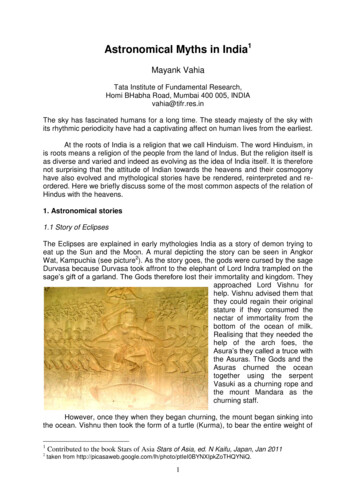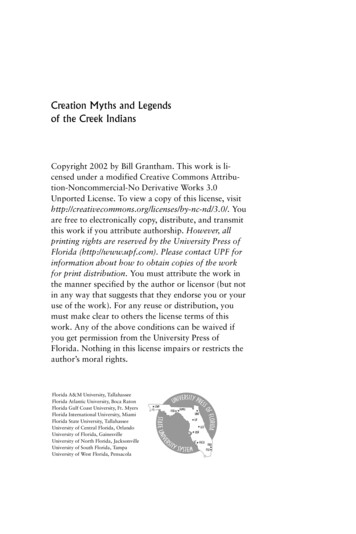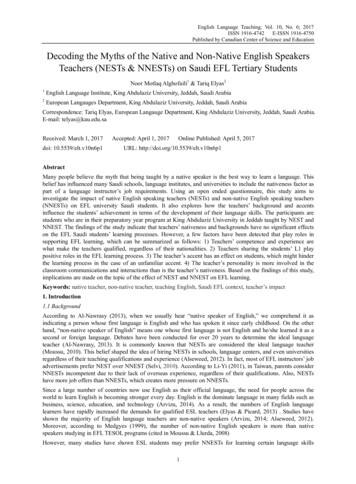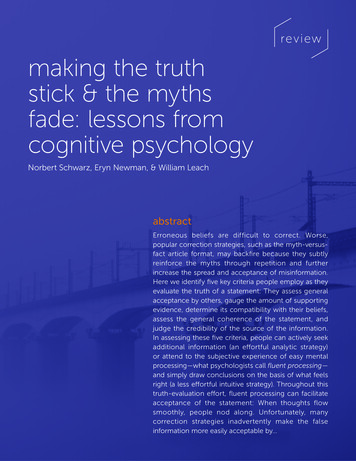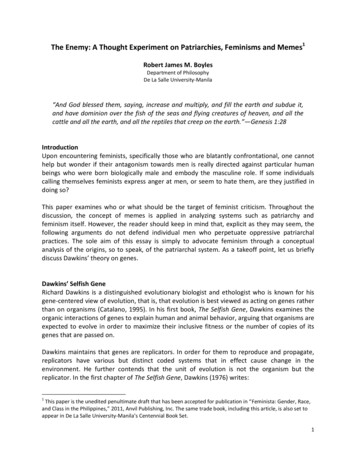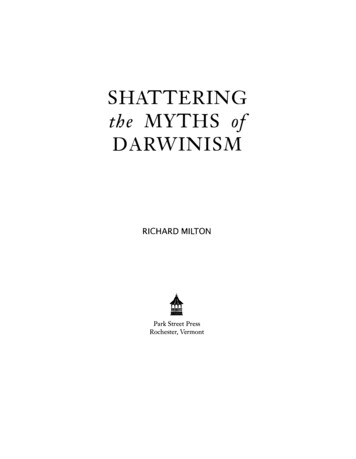
Transcription
SHATTERINGthe MYTHSofDARWINISMRICHARD MILTON Park Street PressRochester, Vermont
Park Street PressOne Park StreetRochester, Vermont 05767.gotoit.comwwwCopyright 1992, 1997 by Richard MiltonFirst U.S. edition published by Park Street Press in 1997Originally published in Great Britain by Fourth Estate LimitedAll rights reserved. No part of this book may be reproduced or utilized inany form or by any means, electronic or mechanical, including photo copying, recording, or by any information storage and retrieval system,without permission in writing from the publisher.LIBRARY oF CoNGREss CATALOGING-IN-PUBLICATION DATAMilton, Richard, 1943[Facts of life]Shattering the myths of Darwinism I Richard Milton.p.em."Originally published in Great Britain by Fourth Estate Limited"T.p. verso.Originally published: Facts of life : London : Corgi Books, 1993.Includes bibliographical references (p.) and indexes.ISBN 0-89281-732-1 (alk. paper)1. Evolution (Biology)-Philosophy. I. T itle.QH360.5.M551997576.8'2-DC2197-9962CIPPrinted and bound in Canada10 9 8 7 6 5 4 3 2 1Text design and layout by Kristin CampT his book was typeset inJ anson with Lucida Sans as the display typefacePark Street Press is a division of Inner Traditions InternationalDistributed to the book trade in Canada by Publishers Group West(PGW), Toronto, Ontario
ContentsPrefacelXPART ONE: CHAOS1.A National Treasure22.Through the Looking Glass3.A Matter of Conjecture154.The Key to the Past?255.Rock of Ages377PART TWO: CLAY6.Tales from Before the Flood587.Fashioned from Clay678.An Element of Unreality809.\Vhen Worlds Collide87The Record of the Rocks9610.PART THREE: CHANCE11.Survival of the Fittest12212.Green Mice and Blue Genes13213.The Beak of the Finch14314.Of Cabbages and Kings15415.The Ghost in the Machine167PART FOUR: CREATION16.Pandora's Box17817.Paradigm Lost18518.Down from the Trees19619.Hopeful Monsters20920.The Facts of Life220
AFTERWORD: CONTROVERSIES21.The Evolution of Evolution23622.On Being Thick Skinned24523.The Fish That Walked25224.Angels Versus Apes25925.Old Theories Never Die273Notes279Bibliography283General Index293People Index302Species Index305
For Julia
Preface"l X THEN THE FIRST EDITION OF THIS BOOK was published, in 1992,V V it was greeted with a storm of controversy no less ferventthan the debate that met the publication of Darwin's theory of evo lution one hundred and thirty years ago.The Times; "Ri Shattering the Myths of Darwinism . could shakeof evolution as much as Honest to God shook popularOn one hand, according to a leading article inchard Milton'sthe 'religion'.Christianity 30 years ago."1While on the other, according to a review by Darwinist Rich ard Dawkins, the book is "loony," "stupid," "drivel" and its authora "harmless fruitcake" who "needs psychiatric help."2WhenShattering the Myths of Darwinism was published, I ex pected it to arouse controversy, because it reports on scientific re search that is itself controversial and because it deals with Darwin ism-always a touchy subject with the biology establishment.I didn't expect science to welcome an inquisitive reporter, but Idid expect the controversy to be conducted at a rational level, thatpeople would rightly demand to inspect my evidence more closelyand question me on the correctness of this or that fact. To my hor ror, I found that instead of challenging me, orthodox scientists sim ply set about seeing me off "their" property.Richard Dawkins, a reader in zoology at Oxford University,wrote his review for the NewStatesman magazine "lest the papercommission someone else who would treat it as a serious scientificIX
PrefaceXtreatise."3 Dawkins devoted two-thirds of his review to attackingmy British publishers, Fourth Estate, for their irresponsibility indaring to accept a book criticizing Darwinism and the remainderto assassinating my own character in the sort of terms quoted above.Dawkins is employed at one of Britain's most distinguisheduniversities and is responsible for the education of future genera tions of students. Yet this is not the language of a responsible sci entist and teacher. It is the language of a religious fundamentalistwhose faith has been profaned.Nature magazine, probably the most highly respected scien tific magazine in the world, scented blood and joined in the frenzy.Its editor, John Maddox, ran a leading article that described me asbelieving science to be a myth (I don't), evolution to be false (Idon't), and natural selection to be a pack of lies (I don't).4 It alsomagisterially rebuked the Sunday Times for daring to devote mostof one of its main news pages to reporting the book's disclosures.5These intemperate responses betoken more than a squabblebetween an inquisitive journalist and a couple of reactionary aca demics. They raise a number of important questions of generalpublic interest. Who do you have to be to have a voice about scien tific research on which large sums of public money are spent? Whodecides who you have to be? In what forum, or by what mechanism,can the voices of dissent ever be heard in science?It is not just outsiders who cannot be heard, it is dissentingmembers of the scientific professions themselves. In my mailboxare letters from biologists who are concerned by the teaching ofDarwinism as holy writ and from medical men whose practices haveled them to make medical discoveries having a bearing on evolu tionary biology. They have sought to publicize these discoveries injournals such as Nature but have been universally rejected becausetheir discoveries are anti-Darwinian in implication and hencecounter to the ruling ideology in the life sciences. They have ap pealed to me-a nonscientist-to help them gain publicity.It is worrying to learn that in countries like Britain and theUnited States, thought to be among the most civilized on Earth,some professional scientists can feel so isolated and ignored thatthey have to take their case directly to the public via the popularpress. Equally, it is depressing to discover that in countries which
PREFACEXlpride themselves on their intellectual tolerance, it is impossible tovoice scientific dissent without attracting this kind of response fromthose who perceive themselves to be the guardians of orthodoxy.In seeking to defend the ideological citadel of Darwinism, themost vociferous critics of this book have allowed their emotions tomislead them so far as to attack me for advocating beliefs that Ihave never held and do not support. Both Richard Dawkins andNature have tried to suggest that I do not believe in evolution andthat I believe the Earth is merely a few thousand years old.To forestall any repetition of false claims like these, let me makemy position clear on both issues from the outset. I accept that thereis persuasive circumstantial evidence for evolution, but I do notaccept that there is any significant evidence that the mechanismdriving that evolution is the neo-Darwinian mechanism of chancemutation coupled with natural selection. Second, I do not believethat the Earth is only a few thousand years old. I present evidencethat currently accepted methods of dating are seriously flawed andare supported by Darwinists only because they provide the billionsof years required by Darwinist theories. Because radioactive dat ing methods are scientifically unreliable, it is at present impossibleto say with any confidence how old the Earth is.
PART ONECHAOS
CHAPTER 1A National TreasureYBTHE RIVER THAMES AT TEDDINGTON, west of London, stragglesa cluster of nondescript factory buildings that seem an unlikelyhome for a national treasure. Yet the buildings are of national im portance to everyone in the United Kingdom because of a few piecesof metal kept there.The buildings are those of the National Physical Laboratory,and the pieces of metal are platinum standards kept at strictly regu lated temperature in air-conditioned chambers to act as the indis putable authority for Britain's national weights and measures, thepound and the kilogram, the yard and the meter.Paradoxically, these standards are never used for everyday pur poses. No one goes to Teddington to measure out a meter of clothor a foot of parcel string. But their mere existence-unchangingand unchallengeable-is the nation's guarantee that standards ex ist: that should it ever be necessary, it is theoretically possible tomake a physical comparison with the accepted measure and saywith absolute certainty that the subject under test either is or is notof the stated weight or length.It's not easy for members of the public to visit the NationalPhysical Laboratory, because it is a busy government research es tablishment and the repository of many secrets. But it is certainlypossible. Those fortunate enough to be given access to the NPLwill see the famous platinum kilogram standard and the atomic2
A National Treasure3clock that is the authority for Greenwich Mean Time. You can checkyour wristwatch and, in principle at least, check up on your 12inch ruler and the weights of your kitchen scales.A few miles to the east of Teddington stands the very muchmore imposing structure of the British Museum of Natural His tory, famous to generations of schoolchildren for its dinosaurs anddramatic reconstructions of the Earth's geological history. Thisbuilding, too, is the repository of a "national standard" but onethat is not on display in a glass case and that has proved very muchmore difficult to track down. The museum is one of the world'sprimary sources or authorities for the theory of evolution by natu ral selection, the theory that is taught in schools and universitiesthe world over: a kind of headquarters for Darwinism.Like millions of people, I have visited the museum many timesto stare in wonder at its contents. But I have been unable to seewith my own eyes the decisive evidence for the general theory ofevolution. I have been able to see many marvels and to study moun tains of evidence: the Geological Column that reconstructs thegeological and biological history of the Earth; the dinosaur skel etons and myriad other fossils; marvels like the skeleton of Archae opteryx, seemingly half bird, half reptile; the reconstructed evolu tion of the horse family. But unlike its counterpart at Teddington,the museum is unable to exhibit the unchallengeable authority thatconclusively demonstrates that evolution by natural selection hastaken place and is established as fact.This is very far from saying that scientists have failed to makethe case for Darwinian evolution. On the contrary, no rational per son can visit this or any other Natural History Museum and not bedeeply impressed by the evidence that has been painstakingly as sembled: evidence of historical development over geological time,of similarity of anatomical structure in many different species, ofchange and adaptation to changing environments. But, frustrat ingly, even with all this evidence, it is impossible for the genuinelyobjective person to say, "Here is the conclusive scientific proof thatI have been looking for."My disappointment among the glass cabinets of Kensingtonwas the beginning of a ten-year journey to try to find that con clusive proof. It has been an Odyssey that has taken me far both
CHAOS4geographically and in time. As a science reporter I am used tobeating a path from library to museum to laboratory and backagain. Now I had to become a scientific historian as well andeven a scientific detective to find the evidence I needed to exam ine afresh. That evidence is of many different kinds and is foundin incongruous and often strange settings: in remote quarries andcoastal cliffs , in libraries and museums, and even in bank vaults.Some can be seen only with the aid of the electron microscopeand some has proved not to exist at all.But although this book has taken me a decade or more toresearch, my immediate reason for writing it is a simple personaldilemma. My daughter Julia has just celebrated her ninth birth day. She is quickly developing an interest in natural history andlike many nine-year-olds is an avid fossil collector and dinosaur spotter. She is beginning to have serious science lessons at herschool and is just now being introduced to the idea that life onEarth has arisen spontaneously from a common ancestor in theremote past and that all the species of animal and plant alive to day have evolved from earlier species. Over the next ten years,she will be taught that the mechanism governing this process isthat of genetic mutation and natural selection-the neo-Darwinistor synthetic theory of evolution.The fact that Julia is beginning to absorb the general theory ofevolution has been giving me sleepless nights. Is Julia being taughtthe truth? Or is she-and are we-being seriously misled?Let me make it clear that my doubts about the general theoryof evolution do not arise from religious objections. I want my daugh ter to have access to the fruits of scientific enquiry, whatever thosefindings should prove to be. But I am seriously concerned, on purelyrational grounds, that generations of school and university teach ers have been led to accept speculation as scientific theory and faultydata as scientific fact; that this process has accumulated a moun tainous catalog of mingled fact and fiction that can no longer becontained by the sparsely elegant theory; and that it is high timethat the theory was taken out of its ornate Victorian glass cabinetand examined with a fresh and skeptical eye.My doubt about the theory arises from a number of sources. Itcomes first and most importantly from the inability of Darwinists
A National Treasure5to pass the simple test described earlier; to show a thinking mem ber of the public conclusive scientific evidence to substantiate thetheory, in the same way that the National Physical Laboratory candemonstrate physical constants, the College of Surgeons can dem onstrate the circulation of the blood, or the Greenwich Observa tory can demonstrate the expanding universe.Second, it comes from the world of scientific investigation it self, a world that I write about in my job as a science reporter andwhere many discoveries that have an important bearing on evolu tion theory have been made in the last two decades, but have re ceived little publicity.Third, and perhaps most eloquently, it comes from the dis armingly direct questions of a nine-year-old child: W here did wecome from? How old is the Earth? Do the butterfly and the el ephant really have a common ancestor?Today, the neo-Darwinist or synthetic theory of evolution en joys unrivalled prominence as the only rational theory to accountfor the origin of species and the evolution of all creatures includinghumankind. It is the only theory of evolution taught in schools,colleges, and universities. It is presented as fact in museum dis plays, lectures, and publications. A few controversial points are re ferred to in museum publications and biology textbooks, but theseare viewed as peripheral controversies, whose outcome cannot al ter the basic truth revealed by neo-Darwinism . The synthetic theoryis universally taken as having been confirmed in all its main essen tials-only a few isolated details remaining to be tidied up by spe cialists in esoteric disciplines such as molecular biology.The teachings of this theory are familiar to everyone educatedin a Western country in the past fifty years. The Earth is of im mense antiquity, formed 4,600 million years ago; life on this planetis also of very great age-emerging spontaneously in ancient seas3,000 million years ago-and the great variety of species that existtoday are all descended from one or a few primitive organismsevolved in those ancient oceans, by a process of random geneticmutation coupled with natural selection. These ideas are the cor nerstones of modern historical geology and of our contemporaryworld view, as familiar to the elementary school pupil as to thepostgraduate student of biology or geology.
CHAOS6To most students, teachers, and even some scientists it will comeas a surprise to learn that recent research into the age of the Earthhas produced evidence that our planet could be much younger thanhad previously been thought: existing methods of geochronometrysuch as uranium-lead decay and radiocarbon assay have been foundto be deeply flawed and unreliable; the extent of genetic change byselection has been found experimentally to be limited; bacteria canbe induced in the laboratory to mutate in a direction that is benefi cial to them-without generations of natural selection; only acatastrophist model of development can account for importantEarth structures and processes such as continental drift and mostfossil-bearing rock formations-most of the Earth's surface in fact.These major discoveries have had profound consequences for theneo-Darwinist theory of evolution, yet few of them have foundtheir way into the public domain, still less into school or universitytextbooks or museum displays.This book attempts to make accessible, and put into context,these new discoveries to enable nonscientists to evaluate for them selves the status of the general theory of evolution and the newlight cast on existing theories by the latest discoveries.A number of books attacking the neo-Darwinist theory-andevolution in general-have been published in recent decades byreligious writers seeking to promulgate biblical creation as an al ternative viewpoint, and I should make it clear at the outset thatthis book is not in any sense a contribution to creationist literature,nor does it represent the creationist viewpoint (although some cre ationist objections to neo-Darwinism that have a basis in scientificresearch are included here).Because some of the scientific matters discussed in this bookare highly controversial, I have included references to original stud ies wherever necessary. However, responsibility for the conclusionsdrawn from these sources is mine alone.
CHAPTER 2Through the Looking GlassWHEN A FAIR-SKINNED WOMAN LIES ON A SUNNY BEACHfor anylength of time, her skin will acquire a tan in response to theSun's ultraviolet rays. The longer she lies on the beach, the darkerher tan will become. But no matter how long she lies on the beach,her children will never be born with her suntan.This everyday experience is at the very heart of the approach toevolution taken by Darwin and his successors. Although apparentlysimple, it encapsulates an immensely sophisticated and detailed bodyof reasoning and natural observations. But it also embodies a funda mental belief that runs counter to intuition, that has proved impos sible to confirm experimentally, and that Darwinists and their oppo nents have fought tooth and nail over for more than 130 years.Darwinists believe that the reason it is impossible for a child toinherit characteristics its parents acquire during their lifetime (suchas the mother's suntan) is that evolution is not supervised by anydirecting force or design, but by chance genetic mutation operat ing together with natural selection. In the example given, this meansthat the black and brown people of the world have not acquireddark pigmentation because they live in sunny regions or because itwould be useful to them to have dark skin to screen the sun's rays.Instead, chance alone has given one or a few ancestors darker skinand natural selection favored the survival of the darker-skinnedpeople because they lived in sunny regions.7
CHAOS8Possibly a darker-skinned person was born in northern lati tudes from time to time, but his or her skin gave no special survivaladvantage and any offspring did not prosper especially so the pre dominant skin tone remains white.Modern Darwinists have actually taken this idea one step fur ther and added a codicil to the theory from the field of molecularbiology. The reason that acquired characteristics cannot be inher ited, many believe, is because the mechanism of inheritance the genes contained in our sexual cells-cannot be constructivelyaffected by the environment. The genetic code is a one-way sys tem. Information can be read out when a new life is generated butinformation cannot be written in to alter the characteristics of thatnew life.' If the offspring differs at all radically from its forebears,believe Darwinists, it is because of random chance and nothingmore. The fundamental mechanism of evolution is, in ProfessorJacques Monad's memorable phrase, "chance and necessity."2 Inthe Darwinian world it is possible to look into the mirror of genet ics and even to read what is written there but, unlike Alice, we cannever go through the looking glass.The Darwinian idea is powerful and beautiful. It has sustainedevolution theory for a century and a half. Many discoveries afterDarwin's death have tended to confirm the idea. And many newideas have been advanced concerning, for instance, the origin oflife from nonliving materials that make use of the Darwinian con cept and that stand head and shoulders above any competing theory.3And yet many people, both scientists and laymen, have enter tained nagging doubts. Do we really believe that black people areblack by accident? What kind of accident was it? Why don't we seesuch accidents happening today? Why does the fossil record notshow us such accidents happening in the past? Once the questionsbegin, it is difficult to know where to stop.For instance, if we don't see genetic mutations-the accidentsof inheritance-happening because they are very rare, then howcan there have been enough of them to produce anything as com plex as humans? Darwinists say this is because many billions ofyears have elapsed since the Earth cooled. The geological stratacovering the Earth's surface have taken millions of years to lay downand the fossil creatures in them lived millions of years ago. But if
Through the Looking Glass9these rocks take millions of years to form, why do we find treesforty feet tall in the vertical position of growth in coal seams?4 Andif nature can produce such rich diversity as the present animal andplant kingdoms by pure chance, why is it that thousands of years ofserious guided selection by humans has resulted only in trivial sub specific variation of domestic plants and animals, while not onenew species has been created?T hese and hundreds of similar questions begin to press for an swers. But before the Darwinian response to those questions canbe evaluated, it is necessary first to gain a firm grasp of just exactlywhat modern Darwinists do believe and, perhaps more importantly,how they came to believe it.T he story begins appropriately enough in a garden-not thatof Eden but rather the Botanical Gardens in Ghent where, in 1898,a 27 -year-old Austrian botanist called Erich Tschermak began totake an interest in breeding garden peas. After only two years' work,trying to breed distinctive characteristics, he found to his astonish ment that the hybrids showed a mathematically precise ratio ofyellow-seeded to green-seeded peas. Reading the literature on peashe found a cross-reference that seemed interesting and in 1900 hesent to the library of Vienna University for the papers.At Amsterdam University, the Professor of Botany, Hugo deVries, made a similarly exciting discovery in 1886. He found cer tain wild varieties of the evening primrose that differed markedlyfrom the cultivated variety. Coining the term "mutation" to de scribe the phenomenon, de Vries started a long series of plant breed ing experiments to see if he could breed mutations. In 1900 hemade a breakthrough that started him searching through theUniversity's literature on pea breeding.In 1892, the instructor of botany at the University ofTubingen,Germany, Carl Erich Correns, conducted some research that re quired him to breed garden peas, and in 1900 he found the samemathematical pattern that his two contemporaries had discernedin their experiments. He, too, searched the literature in the uni versity library and like his colleagues was astonished to discoverthat the entire subject had been researched and published in greatdetail a generation before by an unknown Augustinian monk,Gregor Mendel.
CHAOS10The simultaneous independent discovery by the three men all of whom later had distinguished careers in biology-came at atime when Darwin's theory had been all but consigned to the scrapheap of history. The theory had tottered on for a few years follow ing Darwin's death but had fallen out of favor because it lacked acredible mechanism that could cause change to take place in thespecies that populate the world. Darwin had suggested natural fluc tuations in form, gently edging a species in one direction ratherthan another: like the giraffe's neck getting imperceptibly longerwith each generation. But this phenomenon was nowhere observedin nature. Stability is the norm, not change-however slow-andDarwin's idea of "heritable characters" was simply a nonstarter.When Hugo de Vries found his markedly changed eveningprimroses in the wild, he immediately surmised that he had foundsuch a mechanism: not the trivial "fluctuations" of Darwin but sub stantial "mutations" that accounted for bigger, sudden changes inform. These mutations must be caused by radical changes in thebasic program of heredity-what were later called genes. What deVries and his codiscoverers had observed in pea plants was the ten dency of certain genetic characteristics to dominate in a majorityof offspring-for most of them to be tall when a short pea wascrossed with a tall one. And it was this property, today called thefirst law of genetics, that Gregor Mendel had discovered with hispioneering efforts in the monastery garden in the 1860s.It has often been remarked as strange that Mendel's greatachievement was never realized or acknowledged in his lifetime.His paper was circulated to all of Europe's great libraries and wasreceived by many eminent biologists (including Darwin), none ofwhom saw the importance of his discoveries. But if the Europeanmind was unreceptive in the 1860s, it had become highly receptivefour decades later, and Darwinian evolution theory was rescuedfrom the scrap heap at a single stroke. Combined with Mendeliangenetics, and the concept of mutation, Darwinism reemerged witha solid experimental foundation as the neo-Darwinist or synthetictheory of evolution.In the neo-Darwinist theory, species evolve into other formsby means of natural selection as Darwin had suggested. But theydo so not because of the trivial variation that occurs between all
Through the Looking Glass11individuals but because of chance mutations in their genetic makeup,most of which are neutral or lethal, but a few of which favor achange to a more advantageous form. Thus blind chance combineswith necessity to shape the animal and plant kingdoms.From the rediscovery of Mendel until today, the synthetic theoryhas remained preeminent as the only scientific theory to accountfor the origin of species and the evolution of all creatures includingmankind. No other theory is taught in secondary schools (with thepossible exception of the few religious schools that remain outsidethe state sy stem) or in universities and colleges.In the United Kingdom, for instance, the new National Cur riculum for schools lay s down these instructions for teachers ofbiology: "Pupils should develop their knowledge and understand ing of variation and its genetic and environmental causes andthe basic mechanisms of inheritance, selection and evolution."The National Curriculum's Attainment Target on "Genetics andEvolution" specifies pupils' objective as, "Understanding the rela tionship between variation, natural selection and reproductivesuccess in organisms and the significance of their relationship forevolution."So strong has the Darwinian model of evolution become that ithas vanquished and displaced once and for all the lingering chal lengers it once had: Lamarckism or the inheritance of acquiredcharacteristics; various versions of vitalism-the idea that evolu tion is supervised by some nonphy sical natural force; and of coursethe biblical account of creation by an almighty hand. It isunsurprising that the principal opponents of evolution theory, bothin its original form as conceived by Darwin and in its modern syn thetic form, have been individuals who accept the biblical accountof creation, who see Darwinism representing an assault on theirreligious beliefs, and who wish to have the theory given much re duced prominence, especially in education.The movement has been active for most of this century, espe cially in the United States. From the Scopes trial in Tennessee in1925 to creationist pressure groups of the 1990s, religious funda mentalists in America have repeatedly challenged evolutionistswhatever their hue, sometimes successfully, sometimes not.5 Somecreationists are also scientists-a few of considerable academic
CHAOS12standing-and they have offered substantive scientific criticisms ofneo-Darwinism (some of which are included in this book).An important factor in bringing about the universal dominanceand acceptance of Darwinian evolution has been that virtually ev ery eminent professional scientist appointed to posts in the life sci ences in the last 40 or 50 years, in the English-speaking world, hasbeen a convinced Darwinist. These eminent names include mensuch as Gavin de Beer (Professor of Embryology at UniversityCollege London 1945-50 and Director of the British Museum ofNatural History 1950-60),Julian Huxley (Professor of Zoology atKing's College, London University, and Secretary to the LondonZoological Society), ]. B. S. Haldane (Professor of Genetics atLondon University 1933-37 and Professor of Biometry at Univer sity College 1937-57), and C. H. Waddington (Professor of Biol ogy at Edinburgh University). In the United States, leading syn thetic evolutionists have included Ernst Mayr (Professor of Zool ogy at Harvard University 1953-61
Preface "l X THEN THE FIRST EDITION OF THIS BOOK was published, in 1992, V V it was greeted with a storm of controversy no less fervent than the debate that met the publication of Darwin's theory of evo lution one hundred and thirty years ago. On one hand, according to a leading article in The Times; "Ri chard Milt

